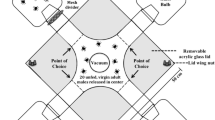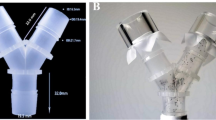Abstract
2,6-Dichlorophenol (2,6-DCP) is the major volatile sex pheromone component in the extracts ofHyalomma dromedarii (35 ng/female) andHyalomma anatolicum excavalum (20 ng/female). The GC fraction containing essentially pure 2,6-DCP, as well as an equal amount of synthetic 2,6-DCP, elicits from the male of each species a hierarchy of responses culminating in attempted copulation.
Similar content being viewed by others
References
Berger, R.S. 1983. Occurrence of 2,6-dichlorophenol inDermacentor albipictus andHaemaphysalis leporispalustris (Acari: Ixodidae).J. Med. Entomol. In press.
Khalil, G.M., Nada, S.A., andSonenshine, D.E. 1981. Sex pheromone regulation of mating behavior in the camel tick,Hyalomma dromedarii (Ixodoidea: Ixodidae).J. Parasitol 67(l):70–76.
Khalil, G.M.,Sonenshine, D.E.,Sallam, O.A., andHomsher, P.J. 1983. Mating regulation and reproductive isolation in the ticksHyalomma dromedarii andH. anatolicum excavatum Koch (Ixodoidea: Ixodidae).J. Med. Entomol. In press.
Leonovich, S.A. 1981. Occurrence of a sex pheromone in the ixodid tick,Hyalomma asiaticum (Ixodidae).Parazitologiya 15(2):150–156.
Sonenshine, D.E., Silverstein, R.M., Plummer, E., West, J.R., andMcCullough, T. 1976. 2,6-Dichlorophenol, the sex pheromone of the Rocky Mountain wood tick,Dermacentor andersoni Stiles and the American dog tick,Dermacentor variabilis (Say).J. Chem. Ecol. 2:201–209.
Wood, W.F., Leahy, (Sister)M.G., Galun, R., Prestwich, G.D., Meinwald, J., Purnell, R.E., andPayne, R.C. 1975. Phenols as pheromones of ixodid ticks: A general phenomenon?J. Chem. Ecol 1:501–509.
Author information
Authors and Affiliations
Additional information
Supported in part by Research Project 3M161102BS10.AD.424, Naval Medical Research and Development Command, National Naval Medical Center, Bethesda, Maryland; in part by contract N00014-80-C-0546, NR 205-039, with the Office of Naval Research, Microbiology Program, Naval Biology Project, Arlington, Virginia; and in part by a grant, AI 10,987 from the National Institute of Allergy and Infectious Diseases, National Institutes of Health, Bethesda, Maryland.
Rights and permissions
About this article
Cite this article
Silverstein, R.M., West, J.R., Sonenshine, D.E. et al. Occurrence of 2,6-dichlorophenol in hard ticks,Hyalomma dromedarii andHyalomma anatolicum excavatum, and its role in mating. J Chem Ecol 9, 1543–1549 (1983). https://doi.org/10.1007/BF00988420
Issue Date:
DOI: https://doi.org/10.1007/BF00988420




